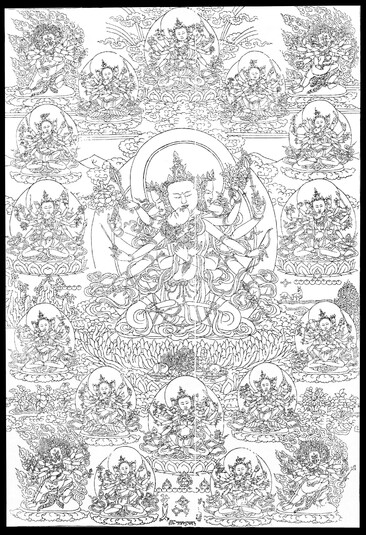
Item: Guhyasamaja (Buddhist Deity) - Manjuvajra
| Origin Location | Eastern Tibet |
|---|---|
| Date Range | 1900 - 1959 |
| Lineages | Sakya and Buddhist |
| Size | 63.50x43.18cm (25x17in) |
| Material | Ground: Paper |
| Collection | Rubin Museum of Art |
| Catalogue # | acc. #C2001.4.112, Gift of William Hinman |
Guhyasamaja, Manjuvajra (Tibetan: sang wa du pa, jam pai dor je. English: Melodious Vajra, Secret Assembly). Bibliographic reference: Shri Vajra Hridaya Lamkara Tantra-nama, Toh 451 and No.44 in the Gyu de Kuntu set of mandalas.
"...Manjuvajra, with a body the colour of purified gold, three faces and six hands. The main face is yellow, the right blue and the left white. The first two hands embrace the Mother. The lower right hands hold a sword and arrow, and the lower left an utpala [flower] and bow; wearing jewel ornaments and having the thirty-two major and eighty minor marks; seated with the legs in the vajra posture. In the lap is the Mother Manjuvajra with three faces and six hands, with the colour, hand objects and embrace, the same as that of the Father. Both are resting in a state of union and emanating forth rays of light." (Written by Jamyang Khyentse Wangchug, 1524-1568 reference).
Lineage of Teachers: Manjuvajra, Buddha Jnanapada, Shri Deva, Vimala Gupta, the two Rinchens, Risul Yogini, Nyen Lotsawa Chogyan, to the Five Masters, Dampa Kunga Drag, Tashi Pal, Kunga Sonam Shap, Do Pal Kirti Shri Khanpa, Sazang Kupon, Ngorchen, Muchen, Gyaltsap Kunkhyen Je, Ratnavardha, Konchog Lhundrup, Sangye Senge, Namkha Pal Zangpo, Chog Leg Khupon, Sempa Chenpo Khyenrab Tendzin Zang, Drowa Sempa Chenpo Khyenrab Tendzin Zang, Drowai Lama Khyenrab Champai Pal, etc.
Jeff Watt 8-2005
Buddhist Deity: Guhyasamaja Main Page
Blockprints: Dege Parkang
Buddhist Deity: Guhyasamaja, Manjuvajra Main Page
